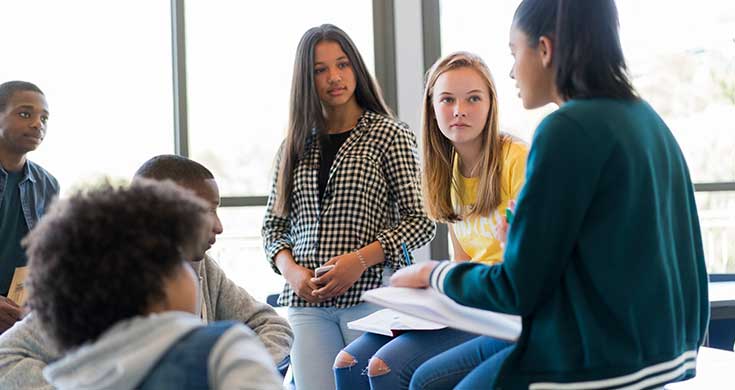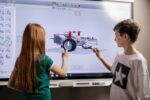Have you ever considered how your child learns at school? For example, does their teacher stand in front of the classroom and give a lecture most of the day? Or does your child have time to explore content on their own and ask questions as they pop up?
There are many different approaches to teaching, and student-centered learning is one that has gained popularity in recent years. Being familiar with teaching methods is a great start for determining which type of learning environment and school is best for your child. So, let’s discuss what student-centered learning is, as well as the origins, benefits, and possible challenges. Plus, we’ll look at the differences in this teaching approach in the online learning environment and a traditional classroom.
The Definition of Student-Centered Learning
Student-centered learning is a style of teaching that allows each student to choose what they study and how they will learn the material. With this teaching method, students are in the driver’s seat of their education, meaning that they’re empowered to take ownership of their learning, giving them a sense of independence in their schoolwork.
Teachers act as mentors and guide students as they explore new material and encourage them to ask questions along the way. This teaching method fosters a personalized learning experience that can be tailored to each student’s academic goals, needs, and interests.
Where did student-centered learning come from?
The origins of student-centered learning can be traced back to the progressive education movement of the early 20th century. During this time, visionaries like John Dewey, who believed that learning is an active process, pushed for a shift from the traditional, teacher-centric methods to teaching approaches that complement the needs and interests of each student.
Since then, teachers and researchers have finetuned the principles of student-centered learning, and it has evolved to what we know it as today—and it’s now a cornerstone of modern education.
What is needed in a student-centered learning environment?
Student-centered learning goes beyond the physical setup of a classroom or the addition of tools—it’s an ongoing process. Let’s take a look at the most important elements of this teaching method and how it works.
A Shift in Mindset
Student-centered learning requires a shift from traditional teaching methods to a model that places students at the center of their own education. It’s not about what the teacher wants—it’s about what works best for each student in reaching their academic goals.
Teacher as a Facilitator
Teachers take on a different role in student-centered learning. They act as facilitators and guide students as they explore new concepts. The emphasis is on mentorship and guidance rather than traditional lecturing.
Personalized Learning Paths
Tailoring learning experiences to each student’s academic goals, needs, and interests is at the heart of student-centered learning. The learning materials and the teacher’s approach should be adaptable to help each student reach their full potential.
Flexibility in Assessment
There are different ways that teachers grade coursework and provide feedback, but not all methods will align with student-centered learning. Teachers need to use an assessment strategy that measures students’ understanding of the material, critical thinking skills, and ability to apply what they’ve learned.
Student Accountability
In a student-centered learning environment, students are responsible for their own learning. They need to set and meet goals, manage their time, and actively engage in their coursework.
Collaboration and Peer Learning
A sense of community is important in a student’s academic journey, and they should be encouraged to interact and learn with their peers.
Access to Resources
Students should have access to a wide range of resources to support their self-directed learning, such as textbooks, digital materials, online research tools, and interactive learning platforms.
Technology Integration
Any technology added to the classroom should complement the learning process and not be used to replace meaningful teacher-to-student interactions. When implemented well, it will encourage the exploration of new content and collaboration with peers.
Learn More: The Importance of Technology Skills for Students
Adaptability and Feedback
The ability to adapt to students’ changing needs is crucial. Regular feedback from both students and teachers will help finetune the learning experience and determine what is working well and what can be improved.
The Benefits of Student-Centered Learning
Student-centered learning is gaining momentum in academic communities. Here are some of the reasons why so many teachers are adopting this teaching method:
Increased Student Engagement
Student-centered learning can help fuel enthusiasm for learning. This is because students get to spend more time exploring topics that they’re passionate about while asking questions along the way.
Stronger Student-Teacher Relationships
The mentorship-style approach and autonomous structure of student-centered learning can help foster strong relationships and feelings of trust between teachers and students.
Developing Critical Thinking Skills
While students explore topics independently in student-centered learning, they are simultaneously developing critical thinking and problem-solving skills.
Enhanced Information Retention
Student-centered learning requires each student to be actively involved in their coursework which can lead to a greater understanding and retention of the content.
Learn More: Strategies to Help Students Remember What They Learn
Preparation for Real-World Challenges
As students immerse themselves in their course content, they build self-motivation and problem-solving skills while developing a sense of ownership in their education.
Improved Self-Esteem
When students have a say in their education and they experience success through self-directed learning, their self-esteem and confidence can grow. This can be a huge win for students who have struggled academically with other teaching methods.
Potential Drawbacks of Student-Centered Learning
It’s clear there are quite a few benefits to student-centered learning, but it can also come with some challenges. As you explore different school options for your child, here are some things to consider when choosing a school that uses student-centered learning.
Difficulty of Implementation
The transition to student-centered learning can be challenging at the beginning for teachers who are used to using traditional teaching methods. Teachers need to be committed to ongoing professional development as well as shifting their mindset and teaching strategies.
Some Students May Not Adapt Well
Many students thrive in student-centered environments, but some may struggle with their sudden increase in responsibility and independence. They will need strong support and guidance from you and their teacher to help keep them on the path to success.
Resource Intensiveness
Student-centered learning requires many additional resources, such as technology, learning materials, and teacher training, and schools need to be committed to placing funds toward these resources to ensure its effectiveness.
Student-Centered Learning in Online Classrooms vs. Traditional Classrooms
Student-centered learning can be used in both online and traditional, in-person classrooms. The concept is the same, but the approach, environment, and learning resources are different. Here is what to expect in online and traditional classrooms that use student-centered learning.
Online Classrooms
In an online classroom, like those powered by K12, student-centered learning is integral to the academic process. A parent acts as a learning coach who helps facilitate the school day, and students have the flexibility to set their pace and explore resources on their own. Teachers incorporate project-based learning to help students learn how to think critically and solve real-world challenges on their own. Students have access to a wide range of online learning materials, get one-to-one time and thoughtful feedback from their teacher, collaborate with other students around the world, and tailor their learning to their own needs and goals.
Learn More: Benefits of Online Learning
Traditional, In-Person Classrooms
Teachers who practice student-centered learning in traditional, in-person classrooms may use the following to support students in leading their own learning:
- Project-based learning: In this approach, students address and solve real-world problems that they may encounter after they graduate.
- Flipped classroom: Students learn new content on their own, which frees up time in the classroom for application and discussion.
- One-to-one time or small groups: Working in smaller groups allows teachers to see each student’s skills and needs, which can lead to intervention and other opportunities to tailor the learning environment when needed.
Student-centered learning helps address your student’s needs.
The benefits of student-centered learning are clear—it empowers students to take control of their education, fosters a deep love for learning, enhances relationships between students and teachers, and nurtures critical thinking skills.
We live in a time when there are many different school options that can complement your child’s unique academic needs and goals—and a school that uses student-centered learning, like K12-powered schools, could help unleash their love for learning. Go to K12.com to learn more about their flexible online programs.



























































































